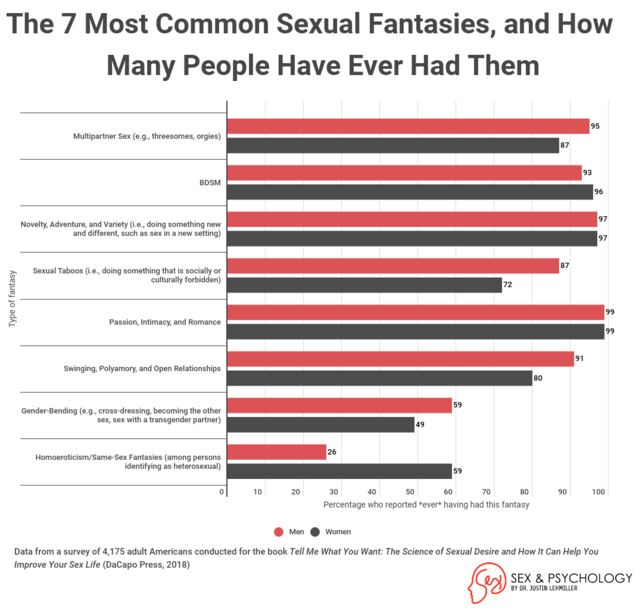Fantasies
Our 7 Most Common Sexual Fantasies
Research uncovers the most popular fantasy themes.
Posted November 18, 2019 Reviewed by Lybi Ma

What is your favorite sexual fantasy?
I asked 4,175 Americans this question as part of the survey that formed the basis for my book Tell Me What You Want. I gave people the opportunity to write out their favorite fantasies in their own words, and many went into great detail. I then looked for common themes in people's descriptions and found that seven broad categories emerged. These included:
1. Multipartner sex. Most often, this included things like threesomes, orgies, and gangbangs.
2. Power, control, and rough sex—anything falling under the umbrella of bondage, discipline, dominance, submission, sadism, and masochism (BDSM).
3. Novelty, adventure, and variety. This refers to doing something that is new and different for you, such as having sex in a new position or setting.
4. Taboo activities. This category involved doing something that you're not "supposed" to do when it comes to sex. A lot of fetish fantasies fell into this category, as well as other fantasies that psychologists have long deemed "paraphilic" (i.e., unusual).
5. Passion, romance, and intimacy. These fantasies involved meeting emotional needs through sex, such as connecting with a partner, or feeling loved, appreciated, and desired.
6. Being in a nonmonogamous relationship. These fantasies involved practicing some form of non-monogamy, such as swinging, polyamory, cuckolding, or having an open relationship.
7. Gender-bending and homoeroticism. This final category was all about pushing the boundaries of your gender identity/role/expression (such as cross-dressing) and/or your sexual orientation (such as being heterosexual but having a same-sex fantasy).
Please note that these categories are not mutually exclusive. There is some overlap between categories, and people can fantasize about more than one of these things at the same time. For instance, a gangbang fantasy might not just be about multi-partner sex—it may also have elements of BDSM, novelty, and sexual taboos. These seven categories simply represent the predominant fantasy themes in the data, and they can potentially be combined in any number of ways.
In addition to asking about people's favorite fantasies, I also asked people whether they've ever had fantasies about various activities. So let's look at how many people said they've ever had each of these seven types of fantasies. The chart below summarizes this data separately for self-identified men and women.

As you can see, most people reported having had several different types of fantasies. In other words, it’s perfectly normal to fantasize about a lot of different things.
A couple of additional notes about the data above:
- For the novelty/adventure/variety category, I based this only on whether people reported fantasies about sex in a new setting (such as sex on a beach, in nature, or in public). If you add in trying other new sexual activities (such as using food during sex or role-playing), the numbers get even closer to 100%.
- For the taboo category, I only focused on the activities listed as “paraphilic” in the DSM other than BDSM, given that BDSM was considered separately. This category focused on things like exhibitionism, voyeurism, frotteurism, and fetishism.
- For the passion/romance/intimacy category, I looked at fantasies about romance, feeling loved or appreciated, feeling desired, pleasing a partner, and emotionally connecting with a partner.
- I separated the gender-bending and homoeroticism fantasies in this table because there was an important (and opposite) gender difference in each type of fantasy. Also, while the numbers for all categories were based on the full sample, I only looked at participants who identified as exclusively heterosexual in the homoeroticism category for obvious reasons.
It is important to note that while these numbers reflect how many people said they’d ever had each type of fantasy, the percentage who fantasied about each theme often or reported that it was their favorite fantasy is lower. For some people, these fantasies are just a one-time thing, whereas, for others, they fantasize about these things frequently.
In addition, while the data here came from a large and diverse sample (over 4,000 adults aged 18-87 from all 50 states), it is not representative of the U.S. population. Participants were largely recruited through social media, which means that their demographics more closely match the average social media user than the average American.
Lastly, remember that just become someone fantasizes about something doesn't necessarily mean that they desire it or want to do it. While there is definitely some overlap between fantasy and desire, these terms are not synonymous.
Facebook image: Look Studio/Shutterstock
References
Lehmiller, J. J. (2018). Tell Me What You Want: The Science of Sexual Desire and How It Can Help You Improve Your Sex Life. Da Capo Lifelong Books.




